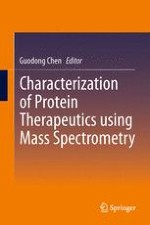2013 | OriginalPaper | Chapter
4. Post-Translationally Modified Proteins: Glycosylation and Disulfide Bond Formation
Authors : Anthony Tsarbopoulos, Fotini N. Bazoti
Published in: Characterization of Protein Therapeutics using Mass Spectrometry
Publisher: Springer US
Activate our intelligent search to find suitable subject content or patents.
Select sections of text to find matching patents with Artificial Intelligence. powered by
Select sections of text to find additional relevant content using AI-assisted search. powered by
